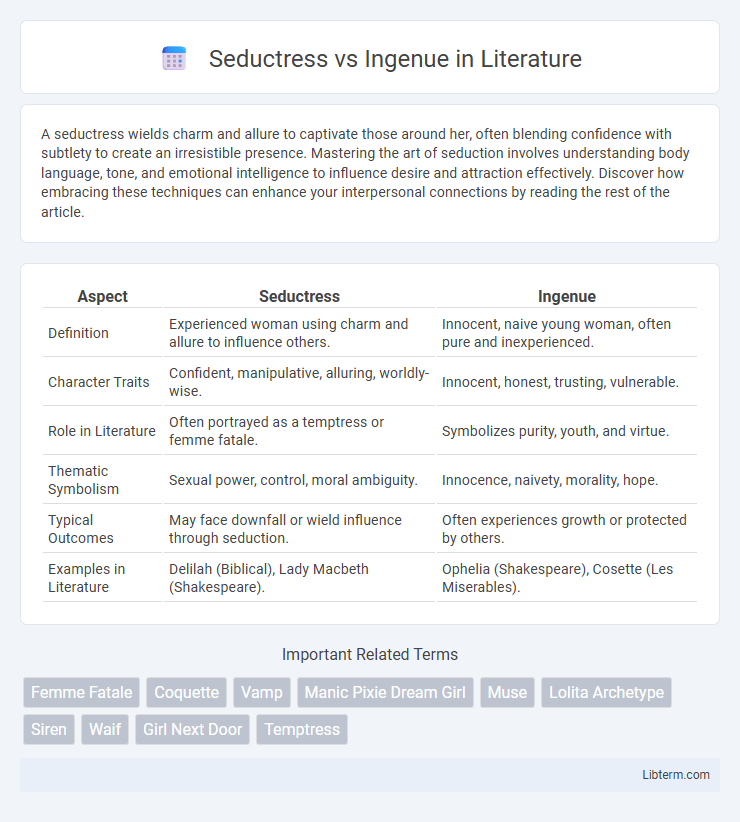A seductress wields charm and allure to captivate those around her, often blending confidence with subtlety to create an irresistible presence. Mastering the art of seduction involves understanding body language, tone, and emotional intelligence to influence desire and attraction effectively. Discover how embracing these techniques can enhance your interpersonal connections by reading the rest of the article.
Table of Comparison
| Aspect | Seductress | Ingenue |
|---|---|---|
| Definition | Experienced woman using charm and allure to influence others. | Innocent, naive young woman, often pure and inexperienced. |
| Character Traits | Confident, manipulative, alluring, worldly-wise. | Innocent, honest, trusting, vulnerable. |
| Role in Literature | Often portrayed as a temptress or femme fatale. | Symbolizes purity, youth, and virtue. |
| Thematic Symbolism | Sexual power, control, moral ambiguity. | Innocence, naivety, morality, hope. |
| Typical Outcomes | May face downfall or wield influence through seduction. | Often experiences growth or protected by others. |
| Examples in Literature | Delilah (Biblical), Lady Macbeth (Shakespeare). | Ophelia (Shakespeare), Cosette (Les Miserables). |
Defining the Seductress: Archetype Unveiled
The Seductress archetype embodies allure, confidence, and mastery over charm, utilizing sensuality and emotional intelligence to captivate others. Rooted in mythology and literature, she often symbolizes power through desire and the navigation of complex social dynamics. This persona contrasts with the Ingenue by emphasizing experience, assertiveness, and an intentional use of attraction rather than innocence or naivety.
The Ingenue Explained: Innocence as Power
The ingenue embodies innocence and naivety, using these traits as a form of subtle power in social dynamics and storytelling. This archetype often captivates through genuine vulnerability and unguarded sincerity, contrasting sharply with the manipulative allure of the seductress. Innocence, when wielded by the ingenue, can disarm opponents, evoke protection, and influence outcomes by appearing refreshingly honest and pure.
Origins in Literature and Myth
The archetype of the Seductress originates from ancient myths such as the Greek figure of Circe, whose enchanting allure and manipulation highlight themes of power and temptation. In contrast, the Ingenue traces back to classical literature and theater, embodying innocence, purity, and naivety, as seen in Shakespearean characters like Ophelia. These roles reflect deep cultural narratives about femininity and morality, influencing countless literary and artistic representations through time.
Key Traits: Seductress vs Ingenue
The seductress is characterized by confidence, allure, and a commanding presence that captivates attention through charm and boldness. In contrast, the ingenue embodies innocence, naivety, and vulnerability, often portrayed with a gentle and wholesome demeanor that evokes empathy and protectiveness. These archetypes differ fundamentally in their social strategies, with the seductress using experience and allure to influence others, while the ingenue relies on purity and sincerity to inspire trust.
Psychological Appeal of Each Archetype
The Seductress archetype appeals through confidence, mystery, and a commanding presence that taps into deep desires for power and allure. The Ingenue archetype evokes innocence, vulnerability, and purity, triggering protective instincts and a longing for genuine connection. Each archetype harnesses distinct psychological triggers: Seductress stimulates attraction through dominance and control, while Ingenue fosters empathy and nurturing through simplicity and authenticity.
Media Representations and Evolution
The media often portrays the seductress as a confident, mysterious woman wielding sexual power, while the ingenue is depicted as innocent, naive, and pure, reflecting traditional gender stereotypes. Over time, these archetypes have evolved, with contemporary media challenging and subverting their simplicity by introducing complex, multi-dimensional female characters who blend traits of both roles. This evolution mirrors broader societal shifts towards recognizing women's diverse identities and rejecting one-dimensional portrayals rooted in outdated norms.
Seductress & Ingenue in Modern Pop Culture
The seductress archetype in modern pop culture embodies confidence, allure, and control, often portrayed as a powerful figure who uses charm and sexuality to influence others, seen in characters like Jessica Rabbit and Beyonce's stage persona. Conversely, the ingenue represents innocence, naivety, and purity, frequently depicted as a young, vulnerable woman navigating complex social or romantic situations, exemplified by characters like Elle Woods in Legally Blonde and characters in Jane Austen adaptations. These contrasting archetypes shape storytelling by highlighting diverse expressions of female identity and empowerment within contemporary media.
Gender Dynamics and Societal Impact
The Seductress archetype, often portrayed as confident and sexually assertive, challenges traditional passive female roles by embracing agency and control within gender dynamics. In contrast, the Ingenue embodies innocence and naivety, reinforcing societal expectations of female purity and submissiveness. These distinct portrayals influence cultural perceptions of women, shaping norms around femininity, power, and sexuality in media and social contexts.
Crossing Boundaries: When Archetypes Overlap
The seductress and ingenue archetypes often intersect when characters display a blend of innocence and allure, challenging traditional boundaries. This overlapping creates complex personas that both magnetize and intrigue, blurring lines between vulnerability and seduction. Such hybridity in archetypes enriches narrative dynamics by exploring themes of power, desire, and identity transformation.
Conclusion: Reimagining Femininity Today
Seductress and ingenue archetypes embody contrasting facets of femininity, with the former exuding confidence and allure while the latter represents innocence and vulnerability. Modern reinterpretations challenge these binaries by embracing diverse expressions of womanhood that honor complexity and individual empowerment. Reimagining femininity today involves dismantling limiting stereotypes, fostering authenticity, and celebrating the multifaceted nature of female identity.
Seductress Infographic

 libterm.com
libterm.com